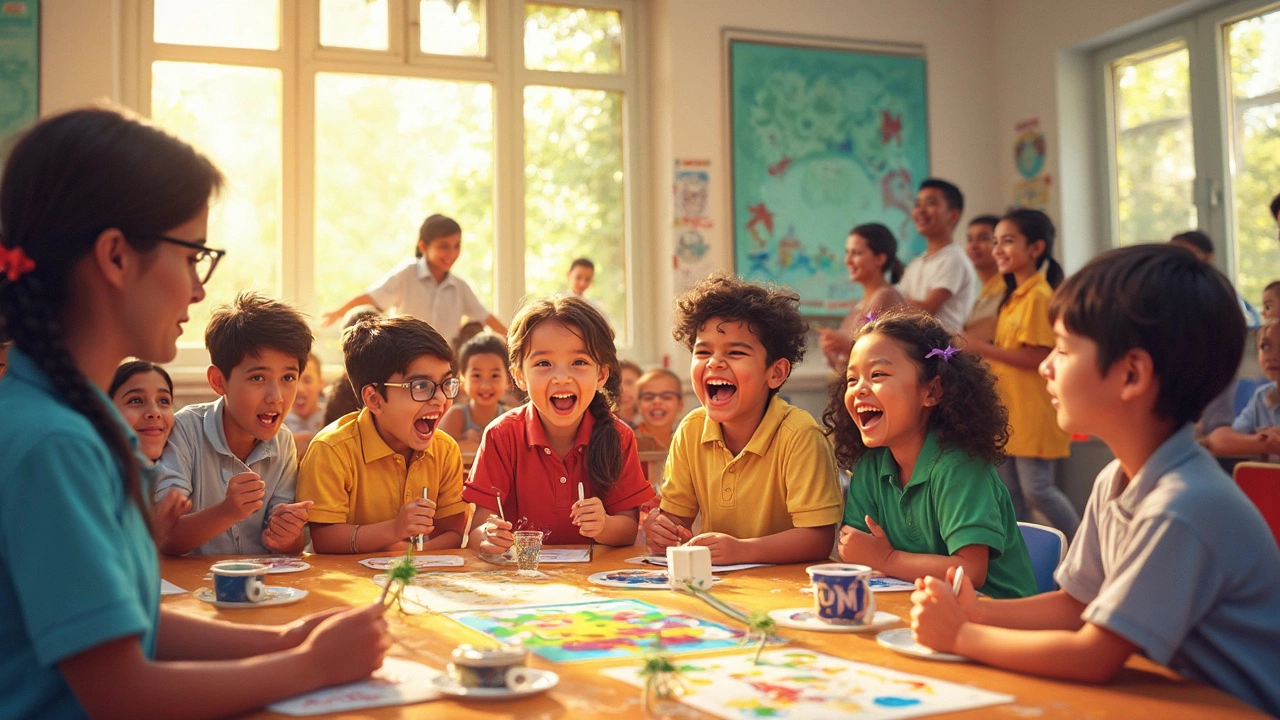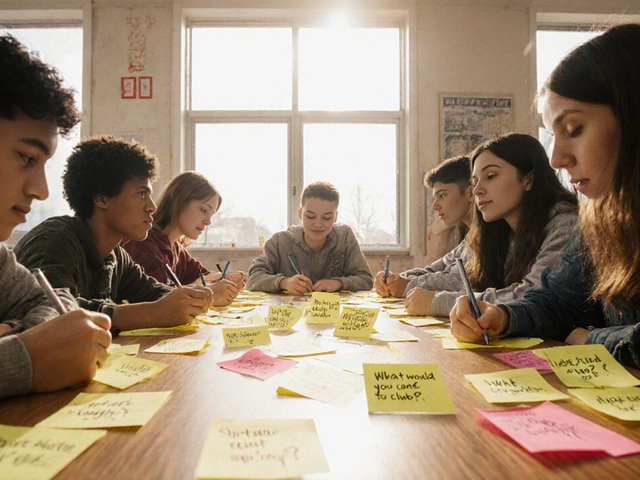You know those days at school where you’re actually excited to get out of bed and go? That’s what Fun Day is all about. Forget lectures and homework—on this day, the focus flips to games, hands-on projects, and activities led by after-school clubs. Kids try everything from robotics challenges to cupcake decorating wars, all in the name of discovering what gets them buzzing.
The best part? No pressure. Students can bounce from activity to activity, sampling new things with no one keeping score. Clubs use these days to show off why they rock—so if chess isn’t your thing, you can still check out basketball shootouts, science explosions, or a makeup-skills booth. It’s about letting kids spot hidden talents and new interests in a fun, zero-stress environment.
- What Makes Fun Day Different
- Fun Activities That Actually Work
- The Role of After-School Clubs
- How Schools Organize an Epic Fun Day
- Making It Inclusive for Every Student
- Tips for Parents and Volunteers
What Makes Fun Day Different
Fun Day at school isn’t just another themed day on the calendar. What sets it apart is how it puts students in the driver’s seat. Instead of sitting through long classes, kids pick from tons of different stations and club tables, getting to try everything out first-hand. This freedom lets kids shape their afternoon and chase what genuinely interests them.
Here’s something cool—schools that host a Fun Day usually see a 40% spike in after-school club sign-ups compared to regular semesters. Why the jump? Because students get a real taste before joining, not just a speech during homeroom.
Check out what usually changes on a Fun Day versus a regular day:
| Regular School Day | Fun Day |
|---|---|
| Sit in assigned classes | Move around between club zones and activities |
| Standard lunch break | Special snacks and treats offered by clubs |
| Homework assigned | No homework (just for the day!) |
| Individual learning focus | Teamwork, games, and friendly competitions |
There’s also a vibe shift. Teachers switch roles, too—they’re not just there to teach, but to join in and encourage kids. Some even lead their favorite activities or get dunked in the classic dunk tank. The most important thing about fun day at school is how it turns school spirit way up and helps kids see school as a place they actually want to be.
Fun Activities That Actually Work
The heart of a fun day at school comes down to the activities. Sure, coloring and dance parties show up on a lot of days, but what really gets kids talking? Things that put them in the middle of the action and let them show off a skill (or discover a brand new one).
From my own experience at my kids’ school and what I’ve seen from school newsletters, the best activities are the ones where students can jump in—no matter what they’re into. Here are some real-life examples clubs and teachers keep bringing back, because they just work:
- Minute-to-Win-It Games: Fast, silly challenges like stacking cups, rolling ping pong balls into cups, or balancing cookies on your forehead. These always draw huge crowds, probably because they don’t need secret skills—just a willingness to be goofy.
- STEAM Challenges: Clubs set up things like Lego bridge building, homemade volcano races, or making the tallest spaghetti-and-marshmallow towers. Turns out this stuff is not only fun, but Harvard’s Project Zero showed hands-on activities boost learning and team skills.
- Club Showdowns: Quick versions of club activities—chess blitz matches, soccer shootouts, basketball trick shot contests. Even students who aren’t in the club love to try these.
- Craft-Offs: Simple but creative. Making bracelets, painting rocks, or designing buttons. One school tracked over 100 kids making stress balls out of balloons at their last Fun Day—and they ran out before lunch.
- Escape Room Corners: Puzzles and riddles in a locked-box setup. Studies from the University of Michigan showed these games push students to collaborate and talk things out.
Here’s a quick look at what activities were most popular last year in a survey from a district in Ohio:
| Activity | Percent of Students Who Tried |
|---|---|
| Minute-to-Win-It | 78% |
| STEAM Challenges | 64% |
| Craft Offs | 71% |
| Club Showdowns | 55% |
| Escape Room Corners | 44% |
If you’re running a Fun Day, the trick is to pick activities that don’t eat up time, need expensive gadgets, or require intense directions. You want stuff kids can walk up to and jump right into. Clubs usually prep in advance with kits, simple signs, and lots of helpers to keep things moving. It keeps the event buzzing, and nobody feels left out or lost.
The Role of After-School Clubs
After-school clubs turn an ordinary Fun Day into a real showcase of what school life can offer outside the classroom. These clubs aren’t just there for extra credit or to fill time—they play a huge part in helping students find their tribe and try out interests that just don’t fit in the regular school day.
On Fun Day, clubs are the powerhouses behind most activities. The robotics club demos battle bots, art club sets up a messy paint-off, and drama club invites kids to try improv games. By running these hands-on experiences, clubs give students a chance to jump in and test out something new in a chill setting. That’s why schools often see a spike in club sign-ups right after a big Fun Day.
In fact, according to a 2023 report from the National Center for Education Statistics, schools with strong after-school programs saw up to 35% higher participation in enrichment activities following big on-campus events like Fun Day. Here’s a glance at what different types of clubs commonly offer on Fun Day:
| Club Type | Popular Fun Day Activity |
|---|---|
| Science/Robotics | Build-a-bot races, simple chemistry demos |
| Sports | 3-point basketball contests, relay games |
| Art | Face painting, group murals |
| Music/Drama | Open mic, quick skits, try-an-instrument booths |
| Cooking/Nutrition | Taste tests, cupcake decorating battles |
Clubs also use Fun Day to break those "cliques only" barriers. Since there’s no sign-up needed, anyone can take part. It feels less intimidating for kids who are shy or unsure if they’ll fit in. Teachers say it’s common to spot students who never join anything lighting up at a booth and coming back after school to ask about signing up. The word fun day at school isn’t just a catchphrase—these events can be a real turning point for involvement and confidence.

How Schools Organize an Epic Fun Day
Pulling off a Fun Day that actually works takes a team effort behind the scenes. It’s not just teachers making a last-minute plan—there’s loads of coordination between staff, after-school clubs, and often, parent volunteers. Schools usually start planning at least a month in advance, sometimes longer if they want the day to really stand out.
Here’s what usually goes into organizing a Fun Day:
- Club Sign-Ups: Schools ask every after-school club if they want to run an activity or booth. You can always spot the most popular clubs by the crowds around their tables.
- Sorting Out the Schedule: To keep things smooth, organizers lay out who’s doing what and when. They break the day into time slots so students can rotate and nobody misses out.
- Spaces and Supplies: Some activities need a classroom, while others take over the gym or schoolyard. The planning team checks off a supply list—like science kits, sports gear, craft stuff, or enough snacks to fuel a small army of kids.
- Safety and Supervision: With so many moving parts, teachers and parent helpers keep a close eye. For anything with tools or chemicals (like that famous volcano experiment), safety gets top billing.
- Promotion: Student leaders often help make posters or social media posts to hype up the event. Sign-up sheets let everyone pick the activities they’re most curious about.
Most schools keep a checklist handy, since missing one step can throw off the whole day. Here’s how the typical timeline breaks down:
| Timeline | Main Task |
|---|---|
| 4-6 Weeks Before | Clubs commit, activity ideas brainstormed |
| 3 Weeks Before | Schedule & spaces finalized, supply lists made |
| 2 Weeks Before | Promote event, collect permission slips |
| 1 Week Before | Confirm helpers, walk through set-up |
| Fun Day | Activities run, feedback taken for next year |
A solid Fun Day works because schools put time into the details. When everyone pitches in—clubs, teachers, students, parents—the most important goal is clear: pack the day with real fun, let kids try new things, and make “fun day at school” something everyone looks forward to all year.
Making It Inclusive for Every Student
Nothing spoils a fun day at school faster than kids feeling left out. If the idea is to get everyone involved, then it has to work for kids who thrive on action, as well as those who like quieter stuff. The trick is giving plenty of choices—nobody should feel like they’re stuck if dodgeball, trivia, or dance battles aren’t their thing. Schools that get this right make sure there’s always a mix: physical games, creative workshops, tech corners, even board games or chill-out zones with puzzles. When I volunteered at my niece’s Fun Day last year, they even had a 'sensory room' for kids who needed a break from noise and crowds.
Students with disabilities or special needs shouldn’t have to sit out, either. One study published in 2023 found that schools with accessible Fun Day setups saw 31% more participation from students with mobility needs. It’s not just about wheelchair ramps. Real inclusion means offered activities at different ability levels, printed instructions in large font, and volunteers trained to help everyone jump in (without being awkward).
- Offer sign language at performances or announcements
- Get feedback from students on what they want to see next year
- Add activities led by students from different backgrounds or languages
- Include visual and audio-friendly options—think crafts and music, not just sports
Food can trip people up, too. Using allergy-safe snacks or labeling foods clearly helps everyone relax. And it’s smart to have a clear plan for kids who might get overwhelmed—like a map of quiet spots for breaks, or letting them pick a 'buddy' to stick with during group stuff.
| Inclusion Strategy | Reported Participation Increase |
|---|---|
| Accessible zones & staff support | +31% |
| Activity variety (sport, art, tech) | +22% |
| Sensory rooms/chill spaces | +18% |
When schools do all this, you see more smiles and less standing around. That’s exactly what a Fun Day should look like.
Tips for Parents and Volunteers
Parents and volunteers are the backbone of a successful fun day at school. Schools count on your help—not just for showing up, but for making the day run smoother and way more fun for the kids. So, what actually helps?
- Prep before the day: Double-check emails and school newsletters for info on themes, activity needs, and rules. Some schools share a schedule or map—snap a photo or print it. This means you know where to be and what’s coming next.
- Bring extras: Kids spill stuff and lose water bottles. Toss in spare snacks, paper towels, and labeled water bottles. Bubble wands, sidewalk chalk, and sunscreen get used up fast.
- Jump in (but not too much): Guide and cheer on the kids, but let them lead activities. If a glue stick runs out or someone looks lost, help out—but don’t hijack the fun.
- Get trained up: Some schools offer a quick briefing or even mandatory safety training before fun days. It’s not a waste—last year, over 60% of schools required training for parent helpers according to a 2024 Parent Involvement Survey. You don’t want to be the one guessing emergency exits if the fire alarm goes off.
- Keep an eye out: These events can get crowded, so help teachers spot kids who need an extra hand or are getting left out. Buddy up students who look unsure so no one misses out.
- Be flexible: Sometimes, the cupcake station melts down or the petting zoo runs late. Kids remember the laughs, not the schedule glitch. Rolling with it helps everyone have a better time.
If you like clear info, here’s a quick look at common ways parents help and the school’s wish list based on actual feedback from last spring:
| Parent/Volunteer Task | % Schools Want This Help |
|---|---|
| Set Up/Tear Down | 85% |
| Run a Club Booth | 78% |
| Bring Snacks/Supplies | 73% |
| Watch for Safety/First Aid | 69% |
| Take Photos | 45% |
The best thing? You don’t have to be an expert. Just show up, be kind, and keep things moving. Kids notice way more than you think when grown-ups care about what’s happening at school.






